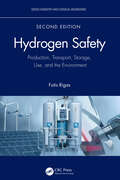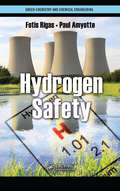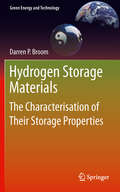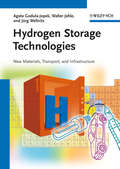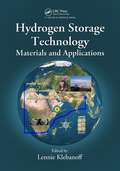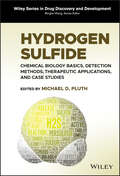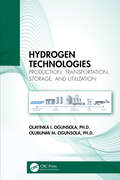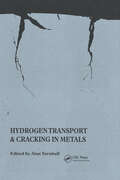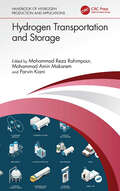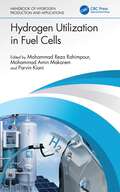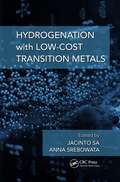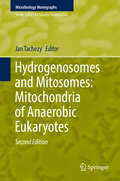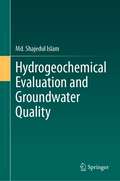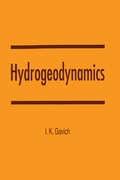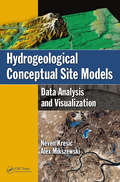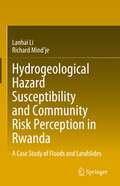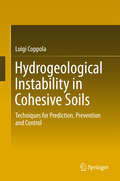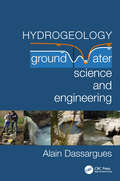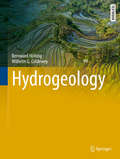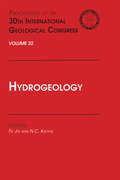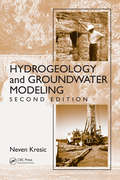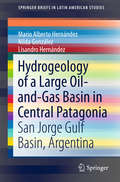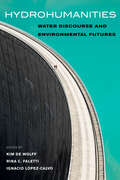- Table View
- List View
Hydrogen Safety: Production, Transport, Storage, Use, and the Environment (ISSN)
by Fotis RigasWhile hydrogen is of vital and growing importance in many industrial sectors, this volatile substance poses unique challenges, including easy leakage, low ignition energy, a wide range of combustible fuel– air mixtures, buoyancy, and its ability to embrittle metals that are required to ensure safe operation. Updated to include the latest advances in the decade since original publication, Hydrogen Safety, Second Edition highlights physiological, physical, and chemical hazards associated with hydrogen production, storage, distribution, and usage systems. Focused on providing a balanced view of hydrogen safety – one that integrates principles from physical sciences, engineering, management, and social sciences – this book is organized to address questions associated with the hazards of hydrogen and the ensuing risks associated with its industrial and public use. This book: Addresses issues of inherently safer design, safety management systems, and safety culture. Features updated case studies of significant accidents involving hydrogen, along with their detailed analysis and lessons learnt, and potential accident scenarios under certain conditions. Details current research trends and perspectives on materials- based hydrogen storage solutions, hydrogen use in vehicles, and hydrogen in construction materials. Describes Process Safety Management as applied to the process industries, in conjunction with the components of the US Department of Energy Safety Plant Elements for hydrogen safety, and covers activities of the European Commission (EC) Network of Excellence for Hydrogen Safety (HySafe). Includes updated codes for gaseous and liquefied hydrogen and the NFPA 2 Hydrogen Technologies Code. Concludes with research and legal requirements. Offering a holistic view of hydrogen safety, from properties to safety systems, this book helps readers in chemical, industrial, safety, and related engineering subjects ensure a safe application and environment.
Hydrogen Safety (ISSN #13)
by Fotis Rigas Paul AmyotteHydrogen Safety highlights physiological, physical, and chemical hazards associated with hydrogen production, storage, distribution, and use systems. It also examines potential accident scenarios that could occur with hydrogen use under certain conditions. The number of potential applications for hydrogen continues to grow-from cooling power statio
Hydrogen Storage Materials
by Darren P. BroomThe problem of storing hydrogen safely and effectively is one of the major technological barriers currently preventing the widespread adoption of hydrogen as an energy carrier and the subsequent transition to a so-called hydrogen economy. Practical issues with the storage of hydrogen in both gas and liquid form appear to make reversible solid state hydrogen storage the most promising potential solution. Hydrogen Storage Materials addresses the characterisation of the hydrogen storage properties of the materials that are currently being considered for this purpose. The background to the topic is introduced, along with the various types of materials that are currently under investigation, including nanostructured interstitial and complex hydrides, and porous materials, such as metal-organic frameworks and microporous organic polymers. The main features of Hydrogen Storage Materials include: an overview of the different types of hydrogen storage materials and the properties that are of interest for their practical use;descriptions of the gas sorption measurement methods used to determine these properties, and the complementary techniques that can be used to help corroborate hydrogen uptake data; andextensive coverage of the practical considerations for accurate hydrogen sorption measurement that drive both instrument design and the development of experimental methodology.Hydrogen Storage Materials provides an up-to-date overview of the topic for experienced researchers, while including enough introductory material to serve as a useful, practical introduction for newcomers to the field.
Hydrogen Storage Technologies
by Agata Godula-Jopek Joerg Wellnitz Walter JehleAn exploration of current and possible future hydrogen storage technologies, written from an industrial perspective. The book describes the fundamentals, taking into consideration environmental, economic and safety aspects, as well as presenting infrastructure requirements, with a special focus on hydrogen applications in production, transportation, military, stationary and mobile storage.A comparison of the different storage technologies is also included, ranging from storage of pure hydrogen in different states, via chemicalstorage right up to new materials already under development. Throughout, emphasis is placed on those technologies with the potentialfor commercialization.
Hydrogen Storage Technology: Materials and Applications
by Lennie KlebanoffZero-carbon, hydrogen-based power technology offers the most promising long-term solution for a secure and sustainable energy infrastructure. With contributions from the world's leading technical experts in the field, Hydrogen Storage Technology: Materials and Applications presents a broad yet unified account of the various materials science, physi
Hydrogen Sulfide: Chemical Biology Basics, Detection Methods, Therapeutic Applications, and Case Studies (Wiley Series in Drug Discovery and Development)
by Binghe WangHYDROGEN SULFIDE Covers H2S interactions, methods of detection and delivery in biological environments, and a wide range of applications Research on hydrogen sulfide (H2S) spans diverse disciplines including chemistry, biology, and physiology. In recent years, new materials and approaches have been developed to deliver H2S and related reactive sulfur species in various clinical contexts. Although many biological pathways involving H2S are complex, all are governed by fundamental chemical interactions between reactive sulfur species and other molecular entities. Hydrogen Sulfide: Chemical Biology Basics, Detection Methods, Therapeutic Applications, and Case Studies provides the foundation required for understanding the fundamental chemical biology of H2S while highlighting the compound’s therapeutic potential and medicinal applications. This book covers key aspects of H2S chemical biology, including the fundamental chemistry of reactive sulfur species; the measurement, detection, and delivery of H2S in biological environments; and the therapeutic and medicinal uses of exogenous H2S delivery in various pharmacologically relevant systems. Throughout the text, editor Michael Pluth and chapter contributors discuss the opportunities and future of the multidisciplinary field. Provides approaches for delivering H2S with relevance to biological and therapeutic applications Describes complex interactions of H2S with bioinorganic complexes and reactive sulfur, nitrogen, and oxygen species Summarizes advances in available tools to detect, measure, and modulate H2S levels in biological environments, such as real-time methods for H2S fluorescence imaging in live cell and animal systems Helps readers understand known systems and make connections to new and undiscovered pathways and mechanisms of action Includes in-depth case studies of different systems in which H2S plays an important role Hydrogen Sulfide: Chemical Biology Basics, Detection Methods, Therapeutic Applications, and Case Studies is an important source of current knowledge for researchers, academics, graduate students, and industrial scientists in the fields of redox biology, hydrogen sulfide research, and medicinal chemistry of small biological molecules.
Hydrogen Sulfide and its Therapeutic Applications
by Hideo KimuraThe metabolism of sulfur especially by sulfurtransferases had been intensively studied in mid 1900's. Three enzymes, cystathionine β-synthase (CBS), cystathionine γ-lyase (CSE) and 3-mercaptopyruvate sulfurtransferase (3MST) were found to have the capacity to produce H2S in vitro. However, H2S was recognized simply as a by-product of the metabolic pathways or as a marker for evaluating the activity of enzymes rather than as a physiological active molecule. In the late 1980's relatively high concentrations of sulfide were measured in the brain that led to the successive studies of identifying the physiological functions of H2S. Recently, the steady-state concentrations of H2S have been re-evaluated and found to be much less than that initially measured. However, despite these differences, such re-evaluations served to further confirm the existence of H2S in mammalian tissues. H2S is produced in almost every organ and plays various roles such as neuromodulation, vasodilation, insulin release, inflammation, angiogenesis and cytoprotection. The unregulated production of H2S and improper responses of target molecules are involved in the pathogenesis of various diseases. This book focuses on these topics as well as on the recent progress in the biology and the therapeutic development of this molecule.
Hydrogen Sulfide and Plant Acclimation to Abiotic Stresses (Plant in Challenging Environments #1)
by M. Nasir Khan Manzer H. Siddiqui Saud Alamri Francisco J. CorpasThis book focuses on the role of hydrogen sulfide in the protection of plants against abiotic stresses and abiotic stress-induced complications by the way of converging advanced key methods of proteomics, genomics, and metabolomics. It provides an update on the biosynthesis, signaling, and mechanism of action of hydrogen sulfide in combating abiotic stresses in plants. Also, special emphasis is given to the interaction of hydrogen sulfide with other signaling molecules (such as nitric oxide, carbon monoxide, hydrogen peroxide etc.), phytohormones, mineral nutrients, ions, and ion channels in plants. This work, uniquely, covers key aspects of hydrogen sulfide signaling in relation to abiotic stresses in plants, including programmed cell death, stomatal movement, and fruit ripening.
Hydrogen Technologies: Production, Transportation, Storage, and Utilization
by Olayinka I. Ogunsola Olubunmi M. OgunsolaOffering a wide-range coverage, this book provides fundamentals as well as the applied science and technology involved in the whole hydrogen value chain, including production, storage, transportation, and utilization. It discusses some challenges and opportunities for hydrogen to address energy demand and climate change issues.Features: Discusses various technology pathways for manufacturing/producing hydrogen both directly (i.e., water splitting) and indirectly (i.e., gas, conversion of coal, and biomass). Covers techniques and technologies for transporting gaseous, liquid, solid, and other forms of hydrogen, including mobile and stationary modes as well as small- and large-scale forms of transportation. Offers techniques and technologies for storing hydrogen with emphasis on materials and physical and chemical characteristics. Describes hydrogen utilization in energy/energy conversion, industrial chemical, industrial agricultural, and transportation sectors. This book is aimed at engineers and scientists working in the disciplines of energy, chemical, environmental, petroleum, petrochemical, and mechanical engineering.
Hydrogen Transport and Cracking in Metals: Proceedings of a Conference Held at the National Physical Laboratory, Teddington, UK, 13-14 April 1994
by Alan TurnbullProceedings of a Conference Held at the National Physical Laboratory, in Teddington, UK, on the 13-14 April 1994, with the main focus of Hydrogen Transport and Cracking in Metals.
Hydrogen Transportation and Storage
by Mohammad Reza Rahimpour Mohammad Amin Makarem Parvin KianiThe success of hydrogen energy markets depends on developing efficient hydrogen storage and transportation methods. Hydrogen may be stored in various ways, including compression, liquefaction, adsorption, hydrides, and reformed fuels. Hydrogen’s application, transport method, storage time, and other factors all have an impact on the technology choices available for its long‑term storage. This book comprehensively reviews hydrogen storage and transportation technologies along with related safety hazards and challenges. Introduces hydrogen storage and transportation materials and standards Includes miscellaneous hydrogen storage methods Covers different hydrogen transportation technologies Comprehensively describes hydrogen storage and transportation safety considerations Provides economic assessments and environmental challenges related to hydrogen storage and transportation Part of the multivolume Handbook of Hydrogen Production and Applications, this standalone book guides researchers and academics in chemical, environmental, energy, and related areas of engineering interested in development and implementation of hydrogen production technologies.
Hydrogen Utilization in Fuel Cells
by Mohammad Reza Rahimpour Mohammad Amin Makarem Parvin KianiHydrogen Utilization in Fuel Cells introduces the fundamentals, characteristics, and applications of fuel cells, materials used, the role of hydrogen in different fuel cell types, and applications of fuel cells in transportation and small portable and stationary power systems. Introduces the electrochemistry and thermodynamics of fuel cells Provides an overview of fuel cells materials Discusses applications of fuel cells in transportation and energy systems Describes the role of hydrogen in various fuel cells Details the kinetics, performance, stability, and environmental challenges of fuel cells Part of the multivolume Handbook of Hydrogen Production and Applications, this stand-alone book guides researchers and academics in chemical, environmental, energy, and related areas of engineering interested in development and implementation of hydrogen production technologies.
Hydrogenation with Low-Cost Transition Metals
by Jacinto Sa Anna SrebowataHydrogenation with Low-Cost Transition Metals describes recent developments in the preparation of catalysts and their catalytic abilities in chemoselective hydrogenation for the production of fine chemicals and pharmaceutical compounds. Emphasizing the use of low-cost metals (Cu, Ni, Fe, and Ag) that are often present in the form of nanoparticles, the book provides valuable reaction mechanism schemes, engineering solutions, and perspective for the field.
Hydrogenosomes and Mitosomes: Mitochondria Of Anaerobic Eukaryotes (Microbiology Monographs #9)
by Jan Tachezy"Hydrogenosomes and Mitosomes: Mitochondria of Anaerobic Eukaryotes" provides a summary of the current knowledge of these organelles which occur in unicellular, often parasitic organisms, including human pathogens. These organelles exhibit a variety of structures and functions. This work describes properties such as protein import, structure, metabolism, adaptation, proteome and their role in drug activation and resistance. Further topics include organelle evolution and biogenesis.
Hydrogeochemical Evaluation and Groundwater Quality
by Md. Shajedul IslamThis book comprehensively discusses the methods and practices for evaluating geochemical processes in aquifer groundwater. Possible occurrence and mechanisms of rock-water interaction, trace metal mobilization, thermodynamic explanation, actions of aquifer CO2, pollution sources, geogenic influencing factors, and isotope dilution methods are the primary areas of focus. These water quality variables are analyzed using a variety of logical/theoretical explanations, statistical techniques, and experimental procedures to determine the suitability of groundwater for drinking, irrigation, and other industrial purposes. The work is an important addition to hydrogeochemical literature since many existing indexing methods for the assessment of water quality are very old and have some degree of limitation. The book will be a useful resource for students, lecturers, and researchers working in the fields of hydrogeochemistry, hydrology, water pollution, and groundwater quality.
Hydrogeodynamics
by I.K. GavichThis text focuses particularly on the growing interest in hydrodynamic principles of the study of underground waters, new methods of eco-based hydrogeodynamic analysis, and the estimation of the quantity of infiltration water transfer. The author also discusses aspects of mass transfer by subsurface water flow in the light of molecular kinetics, and examines a new apporach to investigating the slow movements of groundwater at the deep zones of the hydrolithosphere.
Hydrogeological Conceptual Site Models: Data Analysis and Visualization
by Neven Kresic Alex MikszewskiA reference for students, researchers, and environmental professionals, Hydrogeological Conceptual Site Models: Data Analysis and Visualization explains how to develop effective conceptual site models, perform advanced spatial data analysis, and generate informative graphics for applications in hydrogeology and groundwater remediation. Written by e
Hydrogeological Hazard Susceptibility and Community Risk Perception in Rwanda: A Case Study of Floods and Landslides
by Lanhai Li Richard Mind’jeThis book employs qualitative and quantitative methods to assess and scrutinize the impacts of climatic, topographic, land use, hydrologic and geologic factors on the hydrogeological disasters particularly flood and landslide in Rwanda. The hydrogeological hazard susceptibility and its spatial distribution is also mapped by integrating geospatial techniques and mathematical modeling approach through remote sensing and Geographical Information System (GIS). On the other hand, questionnaires and interview are used to evaluate the community's perception on the risk of hazards. The results unveiled different zones most susceptible to the incidence of both hazards as well as their main contributing factors. Furthermore, the results revealed that the government is perceived as responsible for all mitigation measures instead of being a shared responsibility, a perception that may also contribute to the increase in susceptibility. Therefore, it is necessary to deliver the extent of disaster-related courses and trainings in both schools (from primary to tertiary level) and local community members, which helps improving the public's awareness, understanding and ability by providing a new perspective toward disaster prevention and reduction. The book provides a reference for interested readers to understand the natural and human geography of Rwanda, the distribution of hydrogeological disasters, and the policy-making of disaster prevention and reduction.
Hydrogeological Instability in Cohesive Soils: Techniques For Prediction, Prevention And Control
by Luigi CoppolaThis book discusses techniques for predicting, preventing and controlling the hydrogeological instability of slopes consisting of cohesive soils. The proposed methodology is practical and innovative, and assumes a dynamic valence in defining the deformation process of underground failure as well as its activation through the assumption of a four-dimensional space-time continuum. This latter aspect is crucial for predicting a landslide in time to control it. At present, predicting, preventing and controlling hydrogeological instability in cohesive soils relies on mathematical modelling using specific software, the predictive reliability of which is rather deficient. Such modelling is based upon deterministic processes, which are entirely unsuitable for dealing with the complexity of vital processes occurring during the genesis of a landslide. In this work, the three-dimensional vision of a landslide as a set of distinct and independent phenomena is abandoned and the prediction and prevention of hydrogeological instability is pursued through the alternative of an indivisible totality of natural phenomena that includes the time factor. The book is of interest to graduates and researchers of applied geology, geotechnical, environmental and civil engineering, as well as professionals in the fields of hydrogeology and natural hazards.
Hydrogeology: Groundwater Science and Engineering
by Alain DassarguesThis text combines the science and engineering of hydrogeology in an accessible, innovative style. As well as providing physical descriptions and characterisations of hydrogeological processes, it also sets out the corresponding mathematical equations for groundwater flow and solute/heat transport calculations. And, within this, the methodological and conceptual aspects for flow and contaminant transport modelling are discussed in detail. This comprehensive analysis forms the ideal textbook for graduate and undergraduate students interested in groundwater resources and engineering, and indeed its analyses can apply to researchers and professionals involved in the area.
Hydrogeology: Introduction To Applied Hydrogeology (Springer Textbooks in Earth Sciences, Geography and Environment)
by Bernward Hölting Wilhelm G. ColdeweyThis textbook provides a complete introduction to Hydrogeology. It is a comprehensive reference for earth science professionals involved in groundwater exploitation as well as for geotechnical engineers. This English translation of the German textbook "Hydrogeologie" by Hölting & Coldewey, which has been published in its 8th edition, provides insights into the sources and reservoirs of groundwater, the dynamics of fluid flow, and the physical and chemical composition of groundwater. It also gives an overview about the economic value of groundwater and its exploitation and use. A consistent use of the internationally accepted SI units as well as the formula symbols in the text contributes to the understandability.
Hydrogeology: Proceedings of the 30th International Geological Congress, Volume 22
by Fei JinThis book is a collection of papers presented in the symposia, held in Beijing, on hydrogeology. The papers deal with different topics providing information on some problems on riverside groundwater, assessment of groundwater contamination, and groundwater protection strategy.
Hydrogeology and Groundwater Modeling
by Neven KresicCoupling the basics of hygrogeology with analytical and numerical modeling methods, Hydrogeology and Groundwater Modeling, Second Edition provides detailed coverage of both theory and practice. Written by a leading hydrogeologist who has consulted for industry and environmental agencies and taught at major universities around the world, this unique
Hydrogeology of a Large Oil-and-Gas Basin in Central Patagonia
by Mario Alberto Hernández Nilda González Lisandro HernándezThis book analyzes the most important geohydrological aspects of the San Jorge Gulf Basin (Chubut and Santa Cruz provinces, Argentine Patagonia), with a particular focus on the physical and hydrodynamic characteristics of the system. Discovered in 1907, the San Jorge Gulf Basin was the first petroleum and gas-producing basin in Argentina. It is also one of the most important areas with real prospects for non-conventional exploitation (shale oil-gas). After characterizing the hydroclimatic background (hydrometeorological parameters and water balance), the book describes the main physical aspects: geomorphology, soils and surface as well as subsoil geology, especially lithology, structures, stratigraphy and hydrogeology.
Hydrohumanities: Water Discourse and Environmental Futures
by Kim De Wolff, Rina C. Faletti and Ignacio López-CalvoA free open access ebook is available upon publication. Learn more at www.luminosoa.org. Discourse about water and power in the modern era have largely focused on human power over water: who gets to own and control a limited resource that has incredible economic potential. As a result, discussion of water, even in the humanities, has traditionally focused on fresh water for human use. Today, climate extremes from drought to flooding are forcing humanities scholars to reimagine water discourse. This volume exemplifies how interdisciplinary cultural approaches can transform water conversations. The manuscript is organized into three emergent themes in water studies: agency of water, fluid identities, and cultural currencies. The first section deals with the properties of water and the ways in which water challenges human plans for control. The second section explores how water (or lack of it) shapes human collective and individual identities. The third engages notions of value and circulation to think about how water has been managed and employed for local, national, and international gains. Contributions come from preeminent as well as emerging voices across humanities fields including history, art history, philosophy, and science and technology studies. Part of a bigger goal for shaping the environmental humanities, the book broadens the concept of water to include not just water in oceans and rivers but also in pipes, ice floes, marshes, bottles, dams, and more. Each piece shows how humanities scholarship has world-changing potential to achieve more just water futures.
